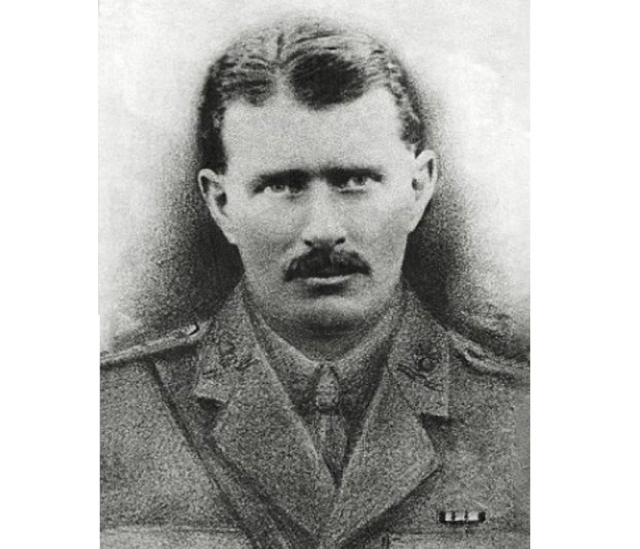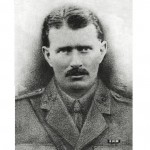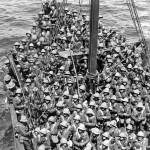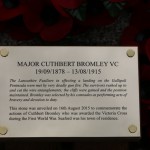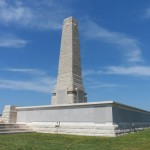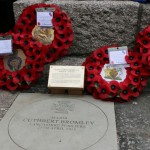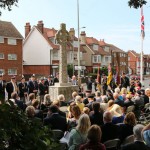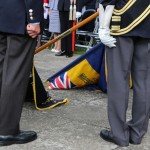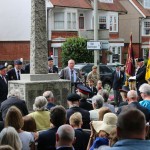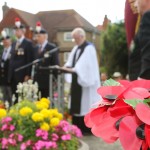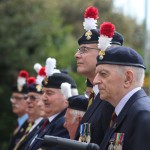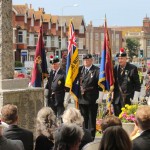The following information is for teachers to utilise in planning classroom activities.
Seaford resident Cuthbert Bromley distinguished himself during the Gallipoli landings on 25 April 1915.
Cuthbert was born in Hammersmith, London before the family moved to live in Seaford. One of four brothers, Cuthbert originally planned on being a doctor or a civil servant after finishing school. However, he eventually settled on the army and joined in 1898. Cuthbert proved to be a strong and capable soldier and served in West Africa before also being stationed in India.
Cuthbert was widely recognised as being incredibly strong and capable of great sporting achievement. Under his leadership, the 1st Battalion of the Lancashire Fusiliers gained a variety of regimental sporting achievements. Cuthbert had also achieved the notable feat of swimming between Malta and Gozo, a feat which is still attempted by swimmers today.
War time service
In 1915 Cuthbert’s regiment was included in the plans for the attack on Gallipoli as part of the Dardanelles Campaign. The original aim of the operation had been to lead an expedition through the Dardanelles Straits and eventually threaten the capital of the Ottoman Empire, Constantinople. However, the Ottoman defences at Gallipoli had prevented British and French ships from sailing past. It was decided to land an infantry force to try and clear the way for the fleet.
On April 25 1915, Cuthbert and his men landed on the beaches. The landings were a disaster. The beach was heavily defended with a mix of barbed wire and land mines, some of which were hidden just below the surface of the water. As a result, many were killed as they exited their boats or drowned. It was during this landing that Cuthbert Bromley performed actions of notable bravery and heroism as reported in the London Gazette.
On the 25th April 1915, headquarters and three companies of the 1st Battalion, Lancashire Fusiliers in effecting a landing on the Gallipoli Peninsula to the West of Cape Helles, were met by very deadly fire from hidden machine guns, which caused a great number of casualties. The survivors, however, rushed up to and cut the wire entanglements, notwithstanding the terrific fire from the enemy, and after overcoming supreme difficulties, the cliffs were gained and the position maintained. Amongst the many very gallant officers and men engaged in this most hazardous undertaking, Captain Bromley, Serjeant Stubbs, and Corporal Grimshaw have been selected by their comrades as having performed the most signal acts of bravery and devotion to duty.
Cuthbert was wounded in the back during this landing but refused to leave his unit for medical treatment. It was only when he received another wound to his leg on the 28 April that he agreed to medical treatment. After a few weeks of recuperation, Cuthbert returned to his men at Gallipoli and, when the commanding officer fell sick on 13 June he was promoted to acting Major. He still held this rank when he led his men into battle at Gully Ravine. To motivate his men Cuthbert gave a stirring speech before leading them over the top. Early in the battle he received a wound to his foot but, once again, refused medical assistance and continued to lead his men forwards. It was not until the following morning once he was sure that the captured position was well defended that he agreed to seek treatment.
The HMT Royal Edward
This final wound saw Cuthbert travel to Cairo for medical treatment for six weeks whilst his foot healed. After his recovery, Cuthbert managed to arrange himself passage onboard the troopship Royal Edward in order to return to Gallipoli from Egypt as quickly as possible.
On 13 August 1915, the Royal Edward, whilst it crossed the Mediterranean at 9am, was intercepted by UB-14, a German submarine and torpedoed. A letter from Lt Col WB Pearson, Cuthbert’s close friend and commanding officer, described the events following the attack on the ship for Lady Bromley, Cuthbert’s mother.
The Royal Edward was struck by one or two torpedoes about 9.am. and went down in about 4 1/2 minutes. Your son was not well that morning – a touch of fever and had not come down to breakfast as usual. As far as I can gather he was one of the last to jump overboard but must have either jumped on some floating wreckage or had some fall on him for he was seen swimming in the water in a half-unconscious state with his forehead damaged. One of our men who knew him helped him onto a collapsible boat but which kept turning over as people tried to climb on. So the awful hours passed until the hospital ship ‘Soudan’ was seen in the distance and your son and this man started to swim for it – but your son was by this time very feeble and told the man to go on and he turned back after about 20 yards and swam back towards the upturned boat crowded with men.
The next details I have is from a semi-official source and says a man – one of ours, who knew him well, who had been rescued in one of the hospital ship boats – was in this boat as it cruised about picking up survivors. They found your son’s body floating in the water and took it on board and tried to revive him, but it was some hours after the original tragedy and he was dead and so his body was consigned once more to the deep, for the boat was nearly filled to the gunwale and there were still some survivors struggling in the water.
In March 1917, Cuthbert’s actions and bravery during the landings at W Beach were formally recognised with the award of a posthumous Victoria Cross. The Victoria Cross is the highest military honour that can be awarded in Britain and is given to those who have shown valour ‘in the face of the enemy’.
Cuthbert was commemorated on the Helles Memorial in modern day Turkey. He is also recognised on the war memorial in his home town of Seaford as well as having a road named after him.
Cuthbert Bromley was honoured with the laying of a VC Paving Stone in Seaford on 16 August 2015.
Questions to ask your students
1) What is a Victoria Cross?
2) How many times was Cuthbert Bromley wounded?
3) Where is Cuthbert Bromley commemorated?
Images
- Cuthbert Bromley VC
- “Lancashire Fusiliers boat Gallipoli May 1915” by Ernest Brooks
- Cuthbert Bromley VC Paving Stone Ceremony – Seaford 16/08/2015
- The Helles Memorial – © Commonwealth War Graves Commission
- Cuthbert Bromley VC – Commemorative Paving Stone Ceremony – Seaford 16/08/2015
- Cuthbert Bromley VC Paving Stone Ceremony – Seaford 16/08/2015
- Cuthbert Bromley VC Paving Stone Ceremony – Seaford 16/08/2015
- Cuthbert Bromley VC Paving Stone Ceremony – Seaford 16/08/2015
- Cuthbert Bromley VC Paving Stone Ceremony – Seaford 16/08/2015
- Cuthbert Bromley VC Paving Stone Ceremony – Seaford 16/08/2015
- Cuthbert Bromley VC Paving Stone Ceremony – Seaford 16/08/2015
Click here to download a copy of this resource: First World War – Cuthbert Bromley – teachers

